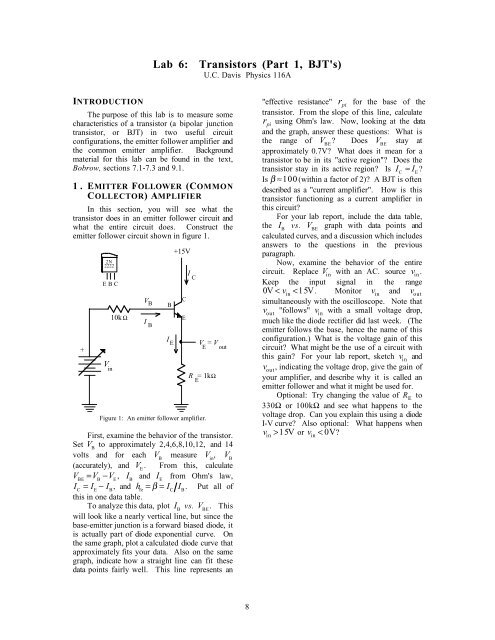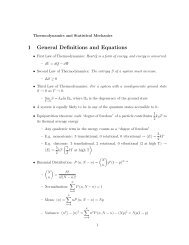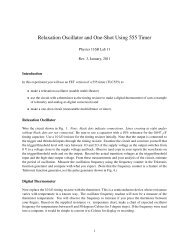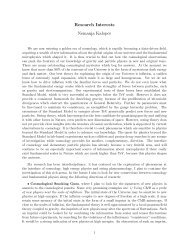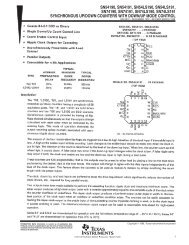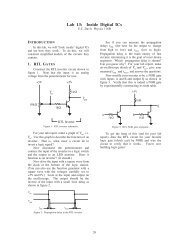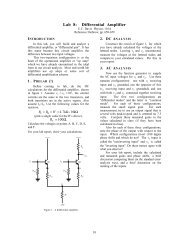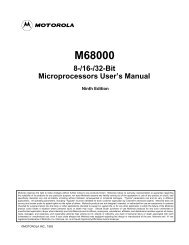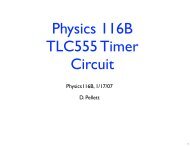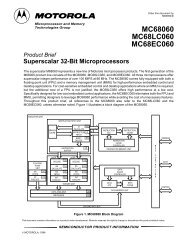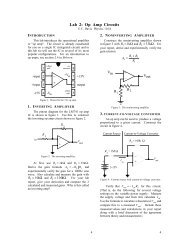BJT and CE Amplifier - UC Davis
BJT and CE Amplifier - UC Davis
BJT and CE Amplifier - UC Davis
Create successful ePaper yourself
Turn your PDF publications into a flip-book with our unique Google optimized e-Paper software.
Lab 6: Transistors (Part 1, <strong>BJT</strong>'s)<br />
U.C. <strong>Davis</strong> Physics 116A<br />
INTROD<strong>UC</strong>TION<br />
The purpose of this lab is to measure some<br />
characteristics of a transistor (a bipolar junction<br />
transistor, or <strong>BJT</strong>) in two useful circuit<br />
configurations, the emitter follower amplifier <strong>and</strong><br />
the common emitter amplifier. Background<br />
material for this lab can be found in the text,<br />
Bobrow, sections 7.1-7.3 <strong>and</strong> 9.1.<br />
1. EMITTER FOLLOWER (COMMON<br />
COLLECTOR) AMPLIFIER<br />
In this section, you will see what the<br />
transistor does in an emitter follower circuit <strong>and</strong><br />
what the entire circuit does. Construct the<br />
emitter follower circuit shown in figure 1.<br />
+<br />
2N<br />
2222<br />
E B C<br />
V<br />
10k Ω<br />
in<br />
V B<br />
I B<br />
B<br />
I E<br />
+15V<br />
C<br />
E<br />
I C<br />
V = V<br />
E out<br />
R = 1kΩ<br />
E<br />
Figure 1: An emitter follower amplifier.<br />
First, examine the behavior of the transistor.<br />
Set V B<br />
to approximately 2,4,6,8,10,12, <strong>and</strong> 14<br />
volts <strong>and</strong> for each V B<br />
measure V in<br />
, V B<br />
(accurately), <strong>and</strong> V E<br />
. From this, calculate<br />
VBE = VB − VE<br />
, I B<br />
<strong>and</strong> I E<br />
from Ohm's law,<br />
IC = IE− IB, <strong>and</strong> hfe = β = IC IB. Put all of<br />
this in one data table.<br />
To analyze this data, plot I B<br />
vs. V BE<br />
. This<br />
will look like a nearly vertical line, but since the<br />
base-emitter junction is a forward biased diode, it<br />
is actually part of diode exponential curve. On<br />
the same graph, plot a calculated diode curve that<br />
approximately fits your data. Also on the same<br />
graph, indicate how a straight line can fit these<br />
data points fairly well. This line represents an<br />
"effective resistance" r pi<br />
for the base of the<br />
transistor. From the slope of this line, calculate<br />
r pi<br />
using Ohm's law. Now, looking at the data<br />
<strong>and</strong> the graph, answer these questions: What is<br />
the range of V BE<br />
? Does V BE<br />
stay at<br />
approximately 0.7V? What does it mean for a<br />
transistor to be in its "active region"? Does the<br />
transistor stay in its active region? Is IC<br />
≈ IE?<br />
Is β ≈100 (within a factor of 2)? A <strong>BJT</strong> is often<br />
described as a "current amplifier". How is this<br />
transistor functioning as a current amplifier in<br />
this circuit?<br />
For your lab report, include the data table,<br />
the I B<br />
vs. V BE<br />
graph with data points <strong>and</strong><br />
calculated curves, <strong>and</strong> a discussion which includes<br />
answers to the questions in the previous<br />
paragraph.<br />
Now, examine the behavior of the entire<br />
circuit. Replace V in<br />
with an AC. source v in<br />
.<br />
Keep the input signal in the range<br />
0V< v<br />
in<br />
< 15V. Monitor v in<br />
<strong>and</strong> v out<br />
simultaneously with the oscilloscope. Note that<br />
v out<br />
"follows" v in<br />
with a small voltage drop,<br />
much like the diode rectifier did last week. (The<br />
emitter follows the base, hence the name of this<br />
configuration.) What is the voltage gain of this<br />
circuit? What might be the use of a circuit with<br />
this gain? For your lab report, sketch v in<br />
<strong>and</strong><br />
v out<br />
, indicating the voltage drop, give the gain of<br />
your amplifier, <strong>and</strong> describe why it is called an<br />
emitter follower <strong>and</strong> what it might be used for.<br />
Optional: Try changing the value of R E<br />
to<br />
330Ω or 100kΩ <strong>and</strong> see what happens to the<br />
voltage drop. Can you explain this using a diode<br />
I-V curve? Also optional: What happens when<br />
>15 V or v in<br />
< 0 V?<br />
v in<br />
8
2. COMMON EMITTER AMPLIFIER<br />
In this section, you will build <strong>and</strong> analyze a<br />
common emitter amplifier, a popular transistor<br />
amplifier circuit. Build the amplifier as shown<br />
in figure 2 but don't connect the AC source yet.<br />
Just leave v in<br />
floating for now.<br />
First, find the bias conditions of the<br />
transistor. That is, find the voltages <strong>and</strong> currents<br />
in the circuit with no input signal. This is also<br />
called the "quiescent point", the "operating<br />
point", or the "DC" conditions for the circuit.<br />
To do this, measure V B<br />
, V E<br />
, <strong>and</strong> V C<br />
, use Ohm's<br />
law to calculate I E<br />
<strong>and</strong> I C<br />
, calculate IB<br />
= IC<br />
β<br />
using the β you found in section 1, <strong>and</strong> calculate<br />
V BE<br />
. The purpose of the resistors in the middle<br />
of the circuit, the "bias resistors", is to keep the<br />
transistor in its active region all the time. Is the<br />
transistor in its active region now?<br />
Now connect the function generator to v in<br />
<strong>and</strong> use a 1V peak-to-peak 10kHz sine wave as<br />
the input signal. Monitor v in<br />
<strong>and</strong> v out<br />
simultaneously with the oscilloscope <strong>and</strong> sketch<br />
them on the same set of axes. Measure the gain<br />
of this amplifier. Compare it to the calculated<br />
gain, RC<br />
RE . Note the phase difference from<br />
input to output. Most amplifiers invert the<br />
signals they amplify.<br />
Explore the behavior of the amplifier a little<br />
more by using different waveforms, frequencies,<br />
<strong>and</strong> amplitudes for v in<br />
. The output of an ideal<br />
amplifier should always look just like the input<br />
multiplied by the gain. However, real amplifiers<br />
only work correctly over a limited range of<br />
output voltages<br />
+15V<br />
<strong>and</strong> frequencies.<br />
Determining these<br />
ranges is an<br />
important part of<br />
116A's classroom<br />
100k Ω<br />
work. See if you<br />
can determine<br />
approximately the<br />
minimum <strong>and</strong> v<br />
in<br />
maximum<br />
frequencies for 0.1 µ F<br />
which the gain is<br />
constant. Also,<br />
see if you can<br />
determine the<br />
range of<br />
10k Ω<br />
acceptable output ~<br />
voltages. Try to<br />
guess what causes<br />
each of these<br />
limits.<br />
4.7 µ F<br />
(add later)<br />
For your report, include your DC<br />
measurements <strong>and</strong> calculations with a brief<br />
discussion of whether the transistor is in its<br />
active region, a sketch of v in<br />
<strong>and</strong> v out<br />
, a<br />
comparison of your measured <strong>and</strong> calculated gain,<br />
<strong>and</strong> some approximate frequency <strong>and</strong> voltage<br />
limits with guesses as to their causes.<br />
Optional: See how the gain changes when<br />
you add the 4.7µF capacitor (drawn with dashed<br />
lines). Can you explain this?<br />
V B<br />
I B<br />
I C<br />
I E<br />
+15V<br />
R = 10k Ω<br />
C<br />
V E<br />
V <strong>and</strong> v<br />
C out<br />
R = 1kΩ<br />
E<br />
Figure 2: A common emitter amplifier.<br />
9


